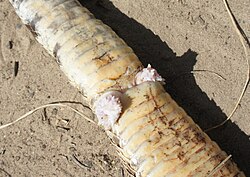Hemipenis Prolapse
Introduction
Prolapse of the one or both of the hemipenes can occur in the male snake. This condition can occur secondary to irritation/inflammation of the hemipenes, inflamation/irritation of the surrounding sheath tissues, trauma or neurological damage to the retractor penis muscles or the presence of a foreign body.
Clinical Signs
The snake will present with one or both of the hemepenes extruded. Severe swelling is common. There may also be evidence of infection, paralysis, maceration or severe trauma.
Treatment
It the snake is presented to the vet shortly after the prolapse has occured, it should be possible to return to hemipenis to its sheath relatively easily once it has been cleaned.
It is more common for the snake to present with a severely swollen and firm hemipenis, and it is impossible to replace it within the sheath. In these cases sugar solutions should be applied to the hemipenis in an attempt to reduce swelling. If this is successful then the hemipenis should be return to the sheath using ample lubrication.
Once the hemipenis has been replaced within the sheath, a purse-string suture should be placed in the pericloacal vent rim to prevent recurrence. It should be left lose enough to allow the passage of urinary wastes and faeces. This should be removed after one week.
Amputation will be required if the hemepenis cannot be returned to the sheath, or if there are signs of infection, paralysis or significant trauma.
Prognosis
Prognosis is very good if amputation is not required, with snakes returning to their full breeding potential.
| Hemipenis Prolapse Learning Resources | |
|---|---|
 Test your knowledge using flashcard type questions |
Reptiles and Amphibians Q&A 02 |
References
Frye, FL & Williams, DL (1995) Self-Assessment Colour Review - Reptiles & Amphibians Manson
